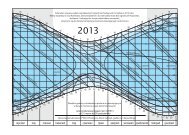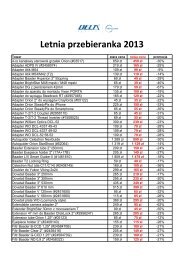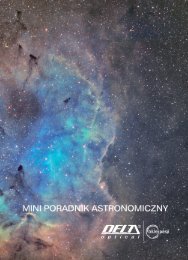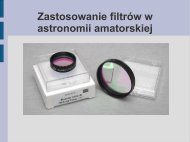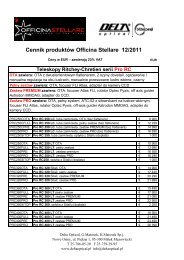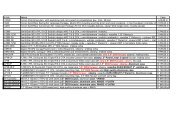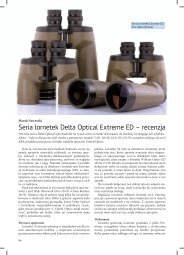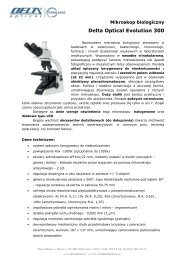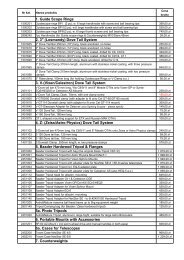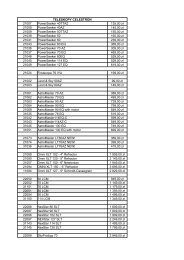Officina Stellare's Veloce RH200 Astrograph - Teleskop-Express
Officina Stellare's Veloce RH200 Astrograph - Teleskop-Express
Officina Stellare's Veloce RH200 Astrograph - Teleskop-Express
You also want an ePaper? Increase the reach of your titles
YUMPU automatically turns print PDFs into web optimized ePapers that Google loves.
S & T Test Report<br />
Dennis di Cicco<br />
<strong>Officina</strong> Stellare’s <strong>Veloce</strong><br />
<strong>RH200</strong> <strong>Astrograph</strong><br />
This 8-inch f/3 catadioptric system hits a lot of<br />
sweet spots for today’s astrophotographers.<br />
The <strong>Veloce</strong> <strong>RH200</strong>’s f/3 focal ratio makes it a superb astrograph for imaging<br />
nebulae with narrowband filters. The author made this view of the<br />
Rosette Nebula using SBIG’s new STT-8300 camera; H-alpha, SII, and OIII<br />
filters; and approximately 2 hours of exposure through each filter.<br />
All photos by the author with additional image processing by Sean Walker<br />
WHAT WE LIKE:<br />
Ideal system for medium-field<br />
deep-sky imaging<br />
Superb image quality across<br />
large CCD chips<br />
Stable focus in changing temperatures<br />
WHAT WE DON’T LIKE:<br />
Unusually heavy for its size;<br />
requires substantial mount<br />
60 April 2013 sky & telescope
While reviewing<br />
imaging equipment a<br />
few years ago, I envisioned an astronomical Rip Van Winkle<br />
awakening from his 20-year snooze to discover a world<br />
of astrophotography unlike anything that existed when he<br />
dozed off. Digital cameras, computerized image processing,<br />
and new telescopes made specifically for astrophotography<br />
were just some of the wonders he’d encounter.<br />
Well, it’s time to dust off that literary conceit for use<br />
again, because today’s awakening Rip would have even<br />
more new wonders to behold. And one that would surely<br />
boggle his mind is <strong>Officina</strong> Stellare’s new <strong>Veloce</strong> <strong>RH200</strong>,<br />
a Riccardi-Honders 200-mm (8-inch) f/3 astrograph.<br />
Indeed, old Rip could have taken a mere catnap and<br />
been surprised by the Riccardi-Honders design, since it<br />
was barely a blip on astrophotography’s radar five years<br />
ago. New designs, not to mention new names for variations<br />
on older designs, continually turn up in the imaging<br />
marketplace. But the Riccardi-Honders design stands out<br />
from the others. Writing in their new book Telescopes,<br />
Eyepieces, and <strong>Astrograph</strong>s (Willmann-Bell, 2012), Gregory<br />
Hallock Smith, Roger Ceragioli, and Richard Berry, state<br />
that “In principle, [the Riccardi-Honders design] is better<br />
than any other astrograph we know.” That’s a pretty powerful<br />
statement given the wide range of high-end imaging<br />
systems currently available.<br />
These authors also note that while the Riccardi-<br />
Honders moniker is relatively new, the design has roots<br />
extending as far back as the early 19th century. Furthermore,<br />
during the latter half of the 20th century, systems<br />
“practically identical” to the Riccardi-Honders were<br />
proposed by various optical designers. For astrophotographers,<br />
however, the ball started rolling soon after the<br />
turn of the millennium when Klaas Honders introduced<br />
amateur telescope makers to a Newtonian variant of<br />
earlier designs. A few years later, Italian optical designer<br />
Massimo Riccardi worked Honders’s system into the<br />
Cassegrain configuration found in today’s astrographs.<br />
In a nutshell, these astrographs have a full-aperture,<br />
single-element meniscus objective, a Mangin-type primary<br />
mirror (basically a meniscus lens that light passes<br />
through twice due to a reflective coating on the back side<br />
of the glass), a convex Cassegrain secondary mirror, and a<br />
corrector lens near the focal plane. The system produces<br />
tight, round star images on a large, flat focal surface<br />
through a wide range of wavelengths. And it can be<br />
made with large apertures and very fast f/ratios. In other<br />
words, the Riccardi-Honders design has the qualifications<br />
required to make it the Holy Grail of astrophotographers.<br />
We borrowed the <strong>Veloce</strong> <strong>RH200</strong> from its Italian manufacturer<br />
for this review. The most basic form of the <strong>Veloce</strong><br />
<strong>RH200</strong> is the optical tube assembly with a Vixen-style<br />
dovetail mounting bar, but without a focuser. The model<br />
we borrowed came with <strong>Officina</strong> Stellare’s robust Crayford-style<br />
focuser (a $200 option), which has precision<br />
Although tested with several cameras, the <strong>RH200</strong> astrograph<br />
worked particularly well with SBIG’s STT-8300 CCD camera and<br />
autoguiding filter wheel pictured here. <strong>Officina</strong> Stellare makes an<br />
80-mm guide scope that fits on the astrograph’s top bracket.<br />
With its dew<br />
cap retracted,<br />
the <strong>RH200</strong> is<br />
not much longer<br />
than it is wide.<br />
But the dew cap<br />
must be fully<br />
extended (seen<br />
below) when the<br />
astrograph is<br />
used, since the<br />
dew cap’s front<br />
aperture forms<br />
an integral part<br />
of the imaging<br />
system.<br />
<strong>RH200</strong><br />
<strong>Astrograph</strong><br />
U.S. price: from $8,395<br />
Available from <strong>Officina</strong><br />
Stellare dealers worldwide<br />
officinastellare.com<br />
SkyandTelescope.com April 2013 61
S&T Test Report<br />
Left: As explained in the text, full-frame DSLR cameras work best when used with special adapter rings. Center: The Riccardi-Honders<br />
optical design in the <strong>RH200</strong> has a full-aperture corrector with an aluminized spot on its back side forming the Cassegrain secondary<br />
mirror. Right: Some camera setups have limited clearance with the optional RoboFocus system (see the accompanying text for details).<br />
tip-tilt adjustments for squaring it to the scope’s optical<br />
axis. The focuser was also fitted with an optional Robo-<br />
Focus motor drive that has a starting price of about $400<br />
and can run upward of $600 depending on the electronic<br />
package ordered with it.<br />
Multiple Sweet Spots<br />
The <strong>Veloce</strong> <strong>RH200</strong> has a lot going for it. The one thing<br />
that immediately catches the eye of even casual astrophotographers<br />
is its unusually fast f/3 focal ratio, which<br />
makes it an ideal instrument for recording faint nebulosity.<br />
It also has 8 inches of aperture, and it is aperture, not<br />
f/ratio, that is the critical factor for imaging faint stars.<br />
Next on the list is its 600-mm focal length and corresponding<br />
image scale of 344 arcseconds per millimeter,<br />
which is enough to resolve fine detail in nebulous objects.<br />
And then there’s field coverage. The <strong>RH200</strong> is spec’d to<br />
cover a 43-mm imaging circle (spanning a 4.1° diameter<br />
field). This imaging circle is big enough to cover a fullframe<br />
DSLR or the popular Kodak KAI-11000 “full-frame”<br />
sensor used in many astronomical CCD cameras. But,<br />
as some of the images with this review show, I also had<br />
excellent results shooting with an even-larger-format<br />
KAF-16803 CCD camera, which requires an imaging<br />
circle 52 mm in diameter for full coverage. When I shot<br />
pictures with the <strong>RH200</strong>, only the very corners of the<br />
large-format chip had degraded star images.<br />
In my opinion, the real “sweet spot” for the <strong>RH200</strong><br />
is when it’s connected to an astronomical CCD camera<br />
having the highly popular KAF-8300 chip. The result is<br />
a system with an image scale of 1.86 arcseconds per pixel<br />
and a very uniformly illuminated field of view covering<br />
1.7° by 1.3°. In the interest of full disclosure, such a setup<br />
is ideal for the medium-field, deep, narrowband imaging<br />
that I like to do. But as much as I’m attracted to the<br />
<strong>RH200</strong> because of these numbers, they are meaningless<br />
if the astrograph doesn’t perform well under the stars.<br />
And that’s where the <strong>RH200</strong> really showed its mettle.<br />
Left: An unprocessed snapshot of the Pleiades in strong moonlight shows that only modest vignetting occurs when a full-frame DSLR<br />
camera is fitted with the large-aperture adapter shown above. Right: Even the brightest stars, such as Zeta Orionis in this 2-hour<br />
H-alpha exposure of the Horsehead Nebula, produce relatively small halos and no ghost images when recorded with the <strong>RH200</strong>.<br />
62 April 2013 sky & telescope
I tested the astrograph with a Nikon D700 full-frame<br />
DSLR; an FLI ProLine 16803 CCD camera, and the new<br />
SBIG STT-8300 CCD camera pictured on page 61 (which<br />
will be reviewed in an upcoming issue). <strong>Officina</strong> Stellare<br />
provided me with adapters for the Nikon and FLI cameras,<br />
and, because of its newness, I machined my own<br />
adapter for the STT-8300. However, I’m sure these will<br />
become commercially available very quickly. Although<br />
it’s possible to use standard T-thread adapters to mount<br />
DSLRs to the <strong>RH200</strong>, these are only suitable for cameras<br />
with APS-size chips. Using full-frame cameras with T<br />
adapters will vignette the corners of the frame due to the<br />
restricted clear aperture of T-thread fittings. There are<br />
several sources, including Borg and <strong>Teleskop</strong>-Service, that<br />
offer large-aperture adapters made specifically for astrophotography<br />
with full-frame DSLR cameras.<br />
Another caveat that goes with mounting cameras to<br />
the <strong>RH200</strong> is its fixed backfocus, which falls about 60 mm<br />
beyond the astrograph’s fully retracted focuser. That can<br />
be rather tight spacing for some setups. For example, the<br />
STT-8300 and its self-guiding filter wheel reached focus<br />
with less than a millimeter to spare between the plug on<br />
the RoboFocus electrical cable and the front of the filter<br />
wheel. And my Nikon would only reach focus when the<br />
camera body was turned such that the protruding front of<br />
the camera avoided the RoboFocus mechanism.<br />
The last item worth mentioning is the <strong>RH200</strong>’s<br />
weight. There’s a lot of glass in the system, and despite its<br />
very compact appearance, it weighs almost 20 pounds (9<br />
kg) without a camera attached. It thus requires a relatively<br />
substantial mount for astrophotography.<br />
Another 200-minute H-alpha exposure made with the FLI ProLine<br />
16803 CCD camera captures a 3.5°-wide field and the brightest<br />
portions of the well-know emission nebula IC 1396 in Cepheus.<br />
Although the detector in the FLI ProLine 16803 CCD camera used for this<br />
200-minute H-alpha exposure of the Veil Nebula covers a greater field than<br />
spec’d for the <strong>RH200</strong>, star images are excellent in all but the corners of the frame.<br />
Overall, the <strong>RH200</strong> performed superbly. Ghost images<br />
were never a problem, and halos around very bright stars<br />
were acceptable (see, for example, the image of the Horsehead<br />
Nebula on the facing page). The focus was remarkably<br />
stable over the temperature variations I experienced on<br />
most nights this past winter. During one 7-hour imaging<br />
sequence last January, I measured star diameters<br />
that tracked perfectly with my target’s changing altitude<br />
despite a temperature drop of 10°F (5.6°C) from start to<br />
finish. I also found no need to refocus the telescope when I<br />
switched color filters while shooting broadband red, green,<br />
and blue images or narrowband images using H-alpha, SII,<br />
and OIII filters. When shooting multi-wavelength image<br />
sets, I’d always focus the <strong>RH200</strong> using the filter closest to<br />
the middle of the wavelength range.<br />
The accompanying photos pretty much speak for the<br />
imaging quality of the <strong>RH200</strong>. As I mentioned above,<br />
because the astrograph is ideally suited for the kind of<br />
imaging I most enjoy doing, I had very high expectations<br />
for the scope before it arrived. And there’s no question<br />
that it lived up to all of them during the time I spent<br />
shooting with it. That, in my opinion, says a lot. ✦<br />
Senior editor Dennis di Cicco needed more than a few catnaps<br />
to catch up on all the sleep he lost while shooting images<br />
with the <strong>Veloce</strong> <strong>RH200</strong> astrograph.<br />
SkyandTelescope.com April 2013 63



